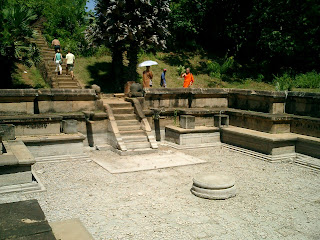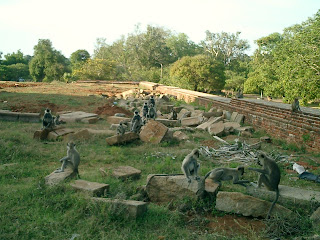Ancient Cities of Sri Lanka: Anuradhapura and polonnaruwa
Thursday, October 2, 2008



King Duttagamini's seven storied Palace

 Medicigiriya Vatadage at Polonnaruwa
Medicigiriya Vatadage at Polonnaruwa Moonstones:
Moonstones:Scholars interpret the figures on the moonstones in different ways. Prof. Paranavitana, basing his arguments mainly on the Abhayagiri moonstones says that the outer circle with the flame motif depicts the secular world as burning in fire. Next comes the design with four animals symbolizing birth, decay, disease and death. It represents the passage of beings through a cycle of births and deaths called samsara. The creepers depict desire of carving, while the row of swans represents purity. The lotus in the centre depicts the Suddhavasa Brahma world. The flight of steps indicate the stages of attainment (patipada) which lead to the final release from transmigration (samsara).
Samadhi Buddha
The weathered limestone statue of Samadhi Buddha, now under a protective canopy in a park-like setting, is the first important relic the visitor comes accross in the Abhayagiri complex at Mahamevuna Park in Anuradhapura, Sri Lanka. The image is depicted in the serene state of Samadhi, or deep meditation and is considered to be one of the best examples in the area. Note that the numerous lotus flowers or other offerings placed by the faithful at the stone bench in front of the Buddha. This is typical at all statues of Buddha throughout the country. It is said that this is one of the best pieces ofsculpture. The statue is 8 feet in height and made of granite and the Dhyana mudra is symbolished - The posture of meditation in which Buddha sits in the cross - legged position with upturned palms, placed one over the other on the lap.
 Thuparama-stupa:
Thuparama-stupa:The stupa was first to be built in the island by king Devanampiyatissa, since the introduction of Buddhism to Sri Lanka in the 3rd century BC. The stupa was built on the instructions of Mahinda Thera with lumps of clay taken from the bed of the Abhaya Tank and constructed in the shape of Paddy-heap (dhanyakara). The Thuparama dagoba northwest of the Ruwanveli Maha Seya, is the oldest in the country. It is believed to enshrine the right collarbone of Lord Buddha, which was a gift from Emperor Asoka after the introduction of Buddhism to Sri Lanka. In 2nd century B.C. it was enclosed in a vatadage (round house) built of wood. In the 7th century the wood pillars were replaced with stone pillars, some of which are still standing today. The present day dagoba was built in the 1860's.

Ruwannveli Seya Stupa:
This stupa was built by king Duttagamini after saving Rajarata from foreign domination. Ruwanveli was known as the Mahathupa as it was the largest in size compared to other stupas in Rajarata. This great stupa with a diameter of about 370ft was constructed on a very strong foundation to prevent it from shaking says the Mahavamsa. The dept of the foundation was said to be 7 cubits which is equivalent to 17.5ft. Huge lime stones were brought and broken with hammers and crushed stones were stamped down by elephants and butter like clay from estuaries was applied on the foundation and pressed. On thee top of it a layer of whitestone and cinnabar with clay were laid and impressed. Enshrining of relics took place at the third level of the circular bans fron the basal terrace of the stupa.

Jetavana Stupa:
The Jetavanarama, a marvel of the heretic King Mahasena (276-303), is the biggest dagoba in the world, currently only a little smaller than the Great Pyramid of Egypt. The massive monument covers 8 acres of land and originally rose to over 400 feet. It is estimated to have housed about 3000 monks. After finishing the reconstruction it is said that the crystal top will shine 152 m above the spectator. In other words the construction will be higher than the pyramid of Cheops in Gizeh.
 Abhayagiri Stupa: King Valagamba ascended the throne in 103 AD. He waged war with the Tamils and was defeated. When he fled, a Nigantha named Giri shouted words of derisive mockery at him. Later the king collected an army attacked the Tamils by slaying the last of their leaders, and recovered the throne he had lost. It is said that he demolished Nigantaramaya (the temple of the Niganthas) and built the Abhayagiri Vihara in the same premises. Shortly after this event, the monks of the Mahavihara took disciplinary action against one of the bhikkus of the Abhayagiri Vihara, for violating a rule of the vinaya. Thereafter the bhikkhus of the Abhayagiri Vihara founded a separate sect there. King Valagamba's reign is marked by an important event - the first schism in Buddhism in Ceylon. Most learned bhikkhus lives in Abhayagiri Vihara. It consisted of a large library. It is recorded that during the reigns of King Voharakatissa and King Gothabhaya this library was destroyed and the heretical monks driven away. King Parakramabahu renovated Abhayagiri Vihara, then the height is said to have been 140 cubits. In the year 1875, Abhayagiri Vihara which had a diameter of 307 feet (94 m) at its base, stood to a height of 231 feet (70 m). The relics of the Buddha are said to have been enshrined in a figure of a bull made out of thick gold.
Abhayagiri Stupa: King Valagamba ascended the throne in 103 AD. He waged war with the Tamils and was defeated. When he fled, a Nigantha named Giri shouted words of derisive mockery at him. Later the king collected an army attacked the Tamils by slaying the last of their leaders, and recovered the throne he had lost. It is said that he demolished Nigantaramaya (the temple of the Niganthas) and built the Abhayagiri Vihara in the same premises. Shortly after this event, the monks of the Mahavihara took disciplinary action against one of the bhikkus of the Abhayagiri Vihara, for violating a rule of the vinaya. Thereafter the bhikkhus of the Abhayagiri Vihara founded a separate sect there. King Valagamba's reign is marked by an important event - the first schism in Buddhism in Ceylon. Most learned bhikkhus lives in Abhayagiri Vihara. It consisted of a large library. It is recorded that during the reigns of King Voharakatissa and King Gothabhaya this library was destroyed and the heretical monks driven away. King Parakramabahu renovated Abhayagiri Vihara, then the height is said to have been 140 cubits. In the year 1875, Abhayagiri Vihara which had a diameter of 307 feet (94 m) at its base, stood to a height of 231 feet (70 m). The relics of the Buddha are said to have been enshrined in a figure of a bull made out of thick gold. Sacred Bo-Tree
Sacred Bo-Tree
Around 245 BC, Sanghamitta Theri brought with her a branch of the Bodhi Tree under which the Buddha attained enlightment. The tree was planted on a high terrace about 21 feet (6.5 m) above the ground and surrounded by railings. Today, the tree is one of the most sacred relics in Sri Lanka, respected by Buddhists all over the world. A wall was built around the tree during the reign of King Kirthi Sri Rajasingha, to protect it from wild elephants. The branches of this sacred "Bo" tree, with a recorded history of more than 2,100 years, seems very slight and fragile. For this reason the branches are supported with iron crutches to prevent any mishaps during heavy rains or strong wind storms. The tree stands among other younger trees, on a special platform, protected by a gold plated railing.

To the east of the Jatavana stupa is found the refectory or the alms-hall of the monastery. The floor of the refectory, like those of similar buildings, is paved with stone slabs. A large rice boat or through sufficient to feed thousand of monks is still to be seen on the spot. Fa –Xien the Chinese traveler records that 5000 monks dwelt at the Abhayagiri Vihara. The stone boat shaped canoe found here is 19 metres long and has the capacity to hold food sufficient for over 5000 monks.

Isurumuniya is situated near Tisawewa and was built by King Devanampiyatissa to house 500 newly-ordained children of high caste. King Kasyapa I (473-491 AD) renovated this viharaya and named it as "Boupulvan, Kasubgiri Radmaha Vehera". This name is derived from names of his 2 daughters and his name. There is a viharaya connected to a cave and above is a cliff. A small stupa is built on it. It can be seen that the constructional work of this stupa belong to the present period. Lower down on both sides of a cleft, in a rock that appears to rise out of a pool, have been carved the figures of elephants. On the rock is carved the figure of a horse. The carving of Isurumuniya lovers on the slab has been brought from another place and placed it there. A few yards away from this vihara is the Magul Uyana.


Guard Stones:
The best guard stone in Sri Lanka is found in front of the Ratnaprasada at Abhayagiri. The guard stones while enhancing the aesthetic beauty of the building protects the balustrades on either sides of the flights of steps. At the southern gate of the Abhayagiri stupa are two guard stones that depicts Sankha and Padma nidhi who represent the great treasures of God Kuvera, the Lord of the wealth. The nagaraja (king cobra) guard stone at the Ratnapasada is an excellent piece of art.















1 comments:
Thank you for sharing these precious photographs and history with us. It looks like it was a really wonderful journey.
Interstingly, I was given the name Anuradha by Yogi monks who live at Orange Farm here in SA
Post a Comment